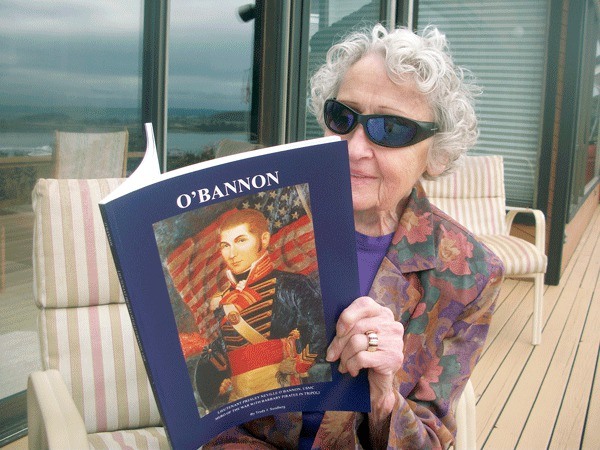Trouble in Tripoli. What’s a president to do?
President Barack O’Bama joined forces with NATO to address the situation. President Thomas Jefferson sent in Lt. Presley Neville O’Bannon, USMC.
O’Bannon was one of the main characters in the United States’ first war in the old world, the First Barbary Coast War of 1801 to 1805. Americans were fed up with what had become a seafaring tradition. Nations paid tribute to allow their ships to pass by the coast of eastern Africa; if not, “Barbary pirates” based in Tripoli, Tunis, Morocco and Algiers would capture merchant ships, torture prisoners and demand tribute.
In the newly minted United States, “Millions for defense, but not one cent for tribute,” became the rallying cry after years of seeing its seamen captured and held for ransom, or of following the humiliating European example by paying tribute.
The war that followed, and Lt. O’Bannon’s part in it, is chronicled by Oak Harbor resident Trudy Sundberg, a retired teacher long active the community. She has updated her earlier work, simply titled “O’Bannon,” to inform today’s public of the troubled history of the Barbary Coast region. She’s also using proceeds to contribute to a fund to bring home the bodies of 13 U.S. sailors killed in 1804 during the Barbary War and buried in Tripoli, as well as to help preserve works of military art.
O’Bannon, an American of humble origins, gained everlasting fame in 1805 when he helped General William Eaton recruit a few hundred Arab and Greek mercenaries in Egypt to complement Bannon’s eight U.S. Marines and march 500 miles across the hostile desert to Tripoli. As a naval battle raged, the ragtag army somehow managed to capture the city where O’Bannon is credited with hoisting the first American flag over an old world capital, and by doing so they added a line to the Marine Corps Hymn’s opening stanza: “From the halls of Montezuma to the shores of Tripoli.”
A few words can not describe the Barbary Wars, which is why reading Sundberg’s book is a must for anyone interested in the roots of what’s going on in the region today. Of the present war she said, “It’s tragic it’s happening but it was inevitable with Gaddafi.”
Sundberg, a longtime student of history, is still amazed that a handful of marines managed to capture Tripoli. “There were eight of them that attacked,” she exclaimed, pointing to an action painting reproduced in her book.
Indeed, besides Sundberg’s fascinating and informative narrative of the war that features other American heroes such as Capt. Stephen Decatur, a highlight of her book is the artwork obtained from numerous sources. Sundberg gives great credit to her son, Kris, and her former student, Kathy Albright, for their “excellent research work.”
A painting by Dennis Malone Carter shows Decatur boarding a Tripolitan gunboat in a famous battle, another shows the eight marines assaulting Derma (Tripoli), an old map shows the route across the desert, while other pictures depict ships and weapons of the day as well as more modern ships named after Barbary Wars heroes.
The United States won the war and struck a blow for freedom of the seas, but as with most wars the ending was not perfect. O’Bannon was disappointed in the political outcome and returned home to eventually serve in elected office in Virginia.
Sundberg, now 86, also wants modern Americans to know of the sacrifices made by their ancestors and their amazing bravery. “These people marched 500 miles with people trying to kill them from all angles. Times were really different,” she said.



